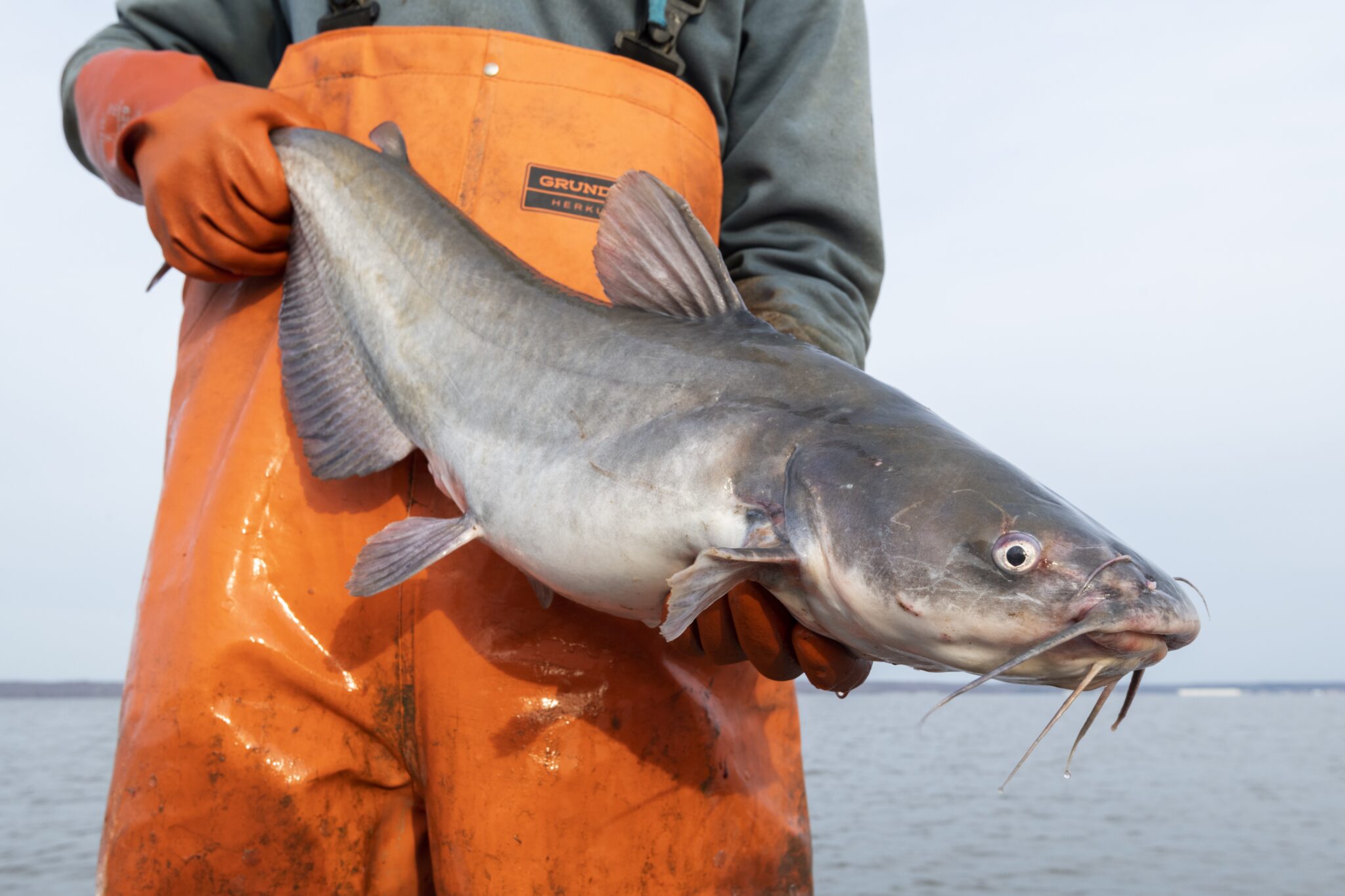
Jay Fleming is aware of blue catfish eat absolutely anything. Nevertheless it wasn’t till just lately, when he visited a fish processing plant in Maryland and began slicing into their bellies, that he absolutely realized the quantity and number of their appetites.
“They’re consuming shellfish, they’re consuming clams, they’re consuming crabs crawling on the underside, they’re consuming fish like perch, they’re consuming fish on the prime of the water column,” Fleming tells Out of doors Life. “ They’re very opportunistic feeders they usually’ve actually discovered an ample meals supply in these rivers of the Chesapeake Bay. And their populations have blown up — massive time.”
Fleming is a 37-year-old professional photographer from Annapolis who has been documenting the rising catfish downside in his beloved homewaters. Blue catfish — native to the Mississippi, Missouri, Ohio, and Rio Grande river basins — have been launched to Virginia by the state recreation company in 1974 and stocked for a decade. By the point fisheries managers realized they’d unleashed a voracious monster that will outcompete native fish and will survive within the brackish water of the bay, it was too late. Now biologists and different conservationists are warning of an invasive critter disaster that threatens all the things from blue crab to striped bass.
Virginia, in the meantime, nonetheless regulates blue catfish as a trophy species, partly to appease the area’s diehard catfishermen. These opposing pursuits — the well being of the native ecosystem and the enjoyable of catching large blue cats — makes it troublesome to handle catfish by way of leisure angling alone. The very best likelihood for preventing catfish, say Fleming, lies in commercializing them.

Photograph by Jay Fleming
Industrial Fishing for Catfish
Fleming is aware of a factor or two concerning the challenges of managing nonnative fish. For 2 years he labored for the Nationwide Park Service, working a gill-net boat to take away invasive lake trout in Yellowstone. As of late, he spends about 250 days a yr on the water of Chesapeake Bay. Usually, it’s operating trot strains for blue catfish. He purchased 1,200 ft of lengthy strains off a industrial fisherman, and now he runs about 100 hooks per line, all baited with reduce gizzard shad.
As a part of his public-awareness campaign, Fleming takes everybody from high-school college students to high-end cooks fishing for cats.

“Folks have this connotation that catfish are muddy backside feeders. I feel that comes from consuming farm-raised catfish that reside in ponds and are fed pellets. However it is a wild fish that’s consuming menhaden, perch, crabs — they’ve a great weight loss program,” says Fleming, who notes that blue catfish caught within the Chesapeake Bay watershed have delicious, mild white fillets. “By encouraging the market, that’s a technique we will attempt to make a dent within the inhabitants.”
Research from 2011 exhibits that blue catfish made up as a lot as 75 p.c of the fish biomass within the tidal James and Rappahannock rivers. That astronomical determine has doubtless elevated within the decade since, as catfish at the moment are in each main tributary of the Chesapeake Bay. (MDNR has some great interactive maps that present the growth of the blue catfish vary over time.) Fleming says the best way to fight a full blue-cat takeover is by leveraging them as a useful resource.

“That is a type of uncommon alternatives the place economics and the setting can work collectively. So by getting these fish out of the water and inspiring a sport fishery for them, which pumps cash into the economic system, and a industrial fishery, which employs watermen, it employs fish homes for slicing, and it brings cash into eating places. That’s a win-win.”
It’s additionally a possibility for annoyed industrial fishermen to pivot. Blue cats goal essential forage fish like alewives and blueback herring, they usually compete with sportfish for a similar prey. Tissue sampling exhibits they eat striped bass eggs, too.
“Striped bass are the bread and butter for lots of people right here, and fisheries like striped bass are in danger due to these blue catfish,” says Fleming. “Industrial fishermen are used to getting regulated each step of the best way. This is likely one of the few fisheries that’s just about unregulated.”
Commercial licenses for blue catfish are simply $15 in Maryland, with no limits or measurement restrictions. And certainly, harvest numbers are rising yr over yr. Within the Potomac River and Maryland waters, industrial blue catfish harvest jumped from 609,525 kilos in 2013 to 4.2 million kilos in 2023, a rise of greater than 500 p.c.
That’s a great begin, however industrial outfits and sport anglers nonetheless have much more fishing to do. To maintain the blue catfish inhabitants secure, Dr. Noah Bressman advised the Teddy Roosevelt Conservation Partnership last year, industrial and sport fishermen must take away between 15 and 30 million kilos of blue cats from the Chesapeake Bay annually. Bressman, an assistant professor within the Division of Biology at Salisbury College, says really lowering the inhabitants would require a a lot greater harvest.
Trophy Catters vs. the World
Fleming by no means expects us to eradicate blue catfish within the Chesapeake Bay watershed. From spotted lanternflies in the Northeast to burmese pythons in the Everglades, controlling invasive species is often a matter of administration, not elimination. One of many major obstacles, now, are anglers themselves.
“Totally different teams of various fishermen have their very own particular pursuits. Among the many striped bass crowd, they agree blue catfish are an issue,” says Fleming. “The striped bass fishermen are fairly supportive of getting as many catfish out of the water as potential. However then we’ve received a complete crowd of individuals, totally on the Potomac and in Virginia — they’re trophy blue catfish folks. They usually’re fairly adamant about blue catfish being regulated as a trophy fishery. In Maryland, it’s broad open. You may kill no matter you catch. Virginia continues to be regulating it as a trophy fishery, which is kinda loopy.”
Fishermen in Virginia do have liberal daily limits of up to 20 fish or no limits in any respect, relying the place you fish, however they often can solely preserve one blue cat longer than 32 inches. In different phrases, Virginia requires massive catfish to be launched as a substitute of killed and faraway from the water. That is one thing catfish record-chasers assist — and that troubles native-fish advocates.
“Who would’ve thought that one thing like this might be political? However it may,” says Fleming, who serves on Maryland’s Invasive Catfish Advisory Committee. The group additionally contains some “trophy catters,” as he calls them. “So there’s a continuing push and pull between the completely different stake holders, and that’s solely going to gradual progress.”

Based on Maryland fisheries biologists, these massive trophy cats may be particularly problematic.
“As soon as they attain an honest measurement, mortality drops off,” even for catfish far smaller than file sizes, MDNR’s invasive fishes program supervisor Branson Williams said last year. “They don’t have predators to fret about.”
Different sportfishermen are sometimes annoyed by the blue cats, which crowd out their goal species.
“They eat virtually any lure you possibly can suppose to throw,” says Derek Horner, OL’s social editor and a former collegiate bass fisherman who has fished all around the East Coast. “Once you discover the blue cats, the bass will vacate an space. Let’s say I fished on a Friday and caught a ton of largemouth on a flat, however then I present up Saturday and catch just a few blue cats. The largemouth are outta there.”
Learn Subsequent: The Master Catfish Trotliners of the White River
Thankfully, Fleming factors out, catching blue catfish isn’t simply a good suggestion for conservation — it’s enjoyable. Blue cats have been dropped at Virginia as a sport fishing alternative, in any case, and people alternatives abound.
”The catfish — they’re not a foul fish,” says Fleming. “They’re simply within the unsuitable place. They usually have a price.”
You may observe Fleming’s images, fishing, and conservation work on Instagram and Facebook.
Trending Merchandise











